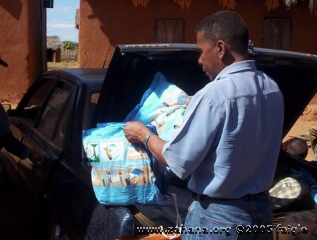Zahana: Malaria Prevention Efforts
 Malaria is a good example of how the needs of the community can be addressed as
Zahana starts working with the villagers of Fiadanana in 2005. (Also see:
Malaria prevention in 2009 in Fiarenena.)
Malaria is a good example of how the needs of the community can be addressed as
Zahana starts working with the villagers of Fiadanana in 2005. (Also see:
Malaria prevention in 2009 in Fiarenena.)
Malaria is the second most common preventable disease in Fiadanana. Diarrhea is still the single most common cause, especially affecting children, but this issue is being addressed by the villagers as they build their own permanent clean water system.
Malaria (Plasmodium falciparum)
is a seasonal disease that affects many parts of Madagascar every year.
Much like the winter flu season in the West, Malaria appears as the winter
season ends each year. Many doctors in Madagascar are still using Chloroquine
as the standard drug of choice. Like in other parts of Africa, Chloroquine
resistance has unfortunately become commonplace in Madagascar, rendering
it rather ineffective. The Ministry of Health and WHO now recommend using
Artemisine instead (for three days), but it is very expensive and forces
many people to fall back on the well-known Chloroquine. Children under
5 years of age and pregnant women are supposed to get free treatment,
but for many people in the countryside this service is not accessible
or available.
In January of 2006 the villagers approached Zahana to provide them
with medication for this year’s Malaria season. While medication is a good immediate stopgap
measure for the individuals affected, it is merely a band-aid for systemic health
problem. To implement a proactive prevention approach Zahana has acquired mosquito
nets (‘bednets’ as they are called in Madagascar) to be distributed
to the villagers.
It is one of the challenges of the Malagasy reality that when
Malaria season comes around mosquito nets are is short supply
and can only be purchased in the parallel market at highly inflated
prices. Through clever diplomacy Zahana was able not only to
secure mosquito nets, but buy them at a subsidized rate for a
fraction of the cost of the ‘open’ market.


In the last site visit to Fiadanana
in June 2006 Zahana representatives were able to deliver 118 mosquito
nets to the community. Transportation costs are exorbitant in Madagascar
and taking them ‘along’ during a site visit was the most
cost effective option. A workshop in the proper use and treatment of
the mosquito nets was held during the distribution to the community.
The distribution of 118 mosquito nets were given out based on with the
following priorities set by the villager’s community consensus:
• Priority was given to pregnant women
• Mothers with children under 3 years of age
• Mothers with children under 5 years of age
• Older mothers
• Zahana women’s group


Most families in Fiadanana only have one bed in their houses that is shared by the entire family at night. Providing a mosquito net for basically every household is therefore a culturally appropriate approach to Malaria prevention and in sync with international Malaria prevention guidelines.
 Mosquito nets are a new technology
for Fiadanana. They have been introduced in the hope that the villagers
will experience the benefits of mosquito nets first hand as the rate
of Malaria drops significantly in the next few months. The families will
treat them as a prized possession and with time, when this technology
gets adopted, Zahana plans to help provide enough mosquito nets for every
child, woman and man in the village. Mosquito nets will need to be treated
with insect repellent every six months to remain effective and may need
to be replaced every two to three years. Once the benefits of the mosquito
nets have been accepted and adopted the additional steps of retreating
and replacing them can be taught and become common practice over the
years.
Mosquito nets are a new technology
for Fiadanana. They have been introduced in the hope that the villagers
will experience the benefits of mosquito nets first hand as the rate
of Malaria drops significantly in the next few months. The families will
treat them as a prized possession and with time, when this technology
gets adopted, Zahana plans to help provide enough mosquito nets for every
child, woman and man in the village. Mosquito nets will need to be treated
with insect repellent every six months to remain effective and may need
to be replaced every two to three years. Once the benefits of the mosquito
nets have been accepted and adopted the additional steps of retreating
and replacing them can be taught and become common practice over the
years.

See: Malaria Prevention in the village of Fiarenana










